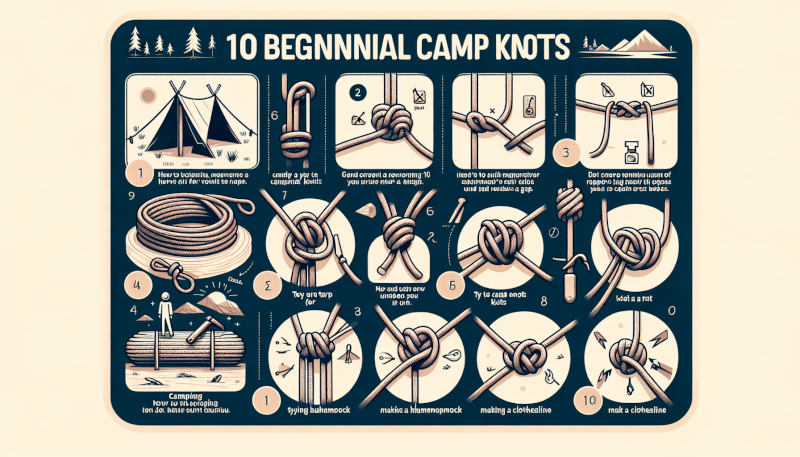If you’re new to camping, mastering a few essential knots can make your outdoor adventures much easier and safer. Whether you’re setting up a tent, securing gear, or creating a clothesline, knowing the right knots can make all the difference. In this article, we’ll guide you through 10 essential knots that every beginner camper should know. These knots are not only practical but also simple to learn, so you can enhance your camping skills and enjoy a worry-free experience in the great outdoors. So grab some rope and get ready to become a knot-tying pro!

1. Introduction to Knots
What are knots?
Knots are a fundamental part of camping, hiking, boating, and many other outdoor activities. They are created by weaving or twisting rope or cordage in specific patterns to secure objects, create structures, or perform various tasks. Knots serve the purpose of joining two ropes together, creating loops, stopping rope from unravelling, or securing items to a fixed point. Mastering a few basic knots is essential for every beginner camper to ensure safety and efficiency while enjoying outdoor adventures.
Importance of knowing basic knots
Knowing basic knots is crucial for every beginner camper for several reasons. Firstly, knots provide a reliable means of securing camping equipment, such as tarps, tent lines, and backpacks, ensuring their stability and preventing potential accidents or damage caused by loose items. Secondly, basic knots enable campers to create improvised tools and structures, such as shelters, clotheslines, and lashing for fortifying tents or constructing furniture. Moreover, knots are invaluable for performing essential tasks like tying up food in proper bear bags, rescuing others in emergencies, or even fashioning makeshift repairs in gear. Overall, learning basic knots not only enhances safety and convenience but also empowers beginners to become more self-reliant and resourceful in the great outdoors.
Types of knots
There are countless knots available, each with its specific purpose and application. However, for the beginner camper, it is essential to start with a few essential knots that will cover most camping needs. Some of the key knots to learn include the overhand knot, figure eight knot, clove hitch knot, square knot, bowline knot, taut line hitch knot, sheet bend knot, two half hitches knot, and prusik knot. Each of these knots will be explored in detail in the following sections, providing step-by-step instructions, common uses, precautions, and variations for each.
2. Overhand Knot
How to tie an overhand knot
The overhand knot is one of the simplest knots to tie. To create an overhand knot, follow these steps:
- Take the end of the rope and cross it over the main part of the rope.
- Pass the end of the rope through the loop created.
- Tighten the knot by pulling both ends of the rope.
Common uses for the overhand knot
The overhand knot is commonly used as a stopper knot to prevent the end of a rope from fraying or slipping through another knot. It can also be used to create small loops for attaching items or connecting two ropes.
Precautions and variations
While the overhand knot is straightforward, be cautious when using it to secure heavy loads or in critical situations as it can sometimes become difficult to untie. Additionally, for added security, a double overhand knot can be used by repeating the process and passing the end of the rope through the loop twice instead of once.
3. Figure Eight Knot
How to tie a figure eight knot
The figure eight knot is another basic knot that is simple to tie. Follow these steps to create a figure eight knot:
- Create a small loop at the end of the rope by folding it back on itself.
- Pass the end of the rope through the loop you just created.
- Bring the end of the rope around and cross it over the main part of the rope.
- Pass the end of the rope through the loop again, this time going under the main part of the rope.
- Tighten the knot by pulling both ends of the rope.
Common uses for the figure eight knot
The figure eight knot is widely used as a stopper knot to prevent a rope from sliding through an opening, such as the end of a belay device or the top of a rope ladder. It is also frequently used in rock climbing and mountaineering as it is easy to recognize and inspect for proper tying.
Precautions and variations
Ensure that the figure eight knot is properly tightened to ensure its effectiveness as a stopper knot. Variations of the figure eight knot include the figure eight follow-through, used for tying into a climbing harness, and the double figure eight knot, which provides added security by creating two parallel loops.
4. Clove Hitch Knot
How to tie a clove hitch knot
The clove hitch knot is a versatile knot that is simple to tie. Follow these steps to create a clove hitch knot:
- Pass the rope around the object you want to secure.
- Cross the rope over itself to create a crossing point.
- Pass the rope over the object again, this time crossing below the first crossing point.
- Pull the rope ends to tighten the knot.
Common uses for the clove hitch knot
The clove hitch knot is commonly used for securing tarps or awnings to poles, attaching boats or canoes to dock posts, and even for setting up temporary clotheslines. It is also frequently used in pioneering projects and knotting systems.
Precautions and variations
When using the clove hitch knot, it is important to ensure that the knot is properly tightened and remains under consistent tension to prevent it from slipping or loosening. Variations of the clove hitch knot include the slipped clove hitch, which allows for quick release, and the double clove hitch, which provides added security by creating two overlapping loops.

5. Square Knot
How to tie a square knot
The square knot, also known as the reef knot, is used to join two ends of a rope or cordage of equal thickness. To tie a square knot, follow these steps:
- Cross the ends of the rope, with the left end over the right end.
- Take the left end and pass it over and under the right end.
- Take the right end and pass it over and under the left end.
- Pull both ends of the rope in opposite directions to tighten the knot.
Common uses for the square knot
The square knot is commonly used to tie a bundle of items together, secure bandages, or connect two ropes of equal diameter. However, it is crucial to note that the square knot should not be used when the ropes are of different diameters, as it can slip or jam under such circumstances.
Precautions and variations
When tying the square knot, ensure that each end is pulled firmly, creating equal tension on both sides. This will prevent the knot from slipping or coming undone. Variations of the square knot include the double square knot, which adds additional security by tying the knot twice, and the granny knot, which should be avoided as it is not as secure as the square knot and can easily come undone.
6. Bowline Knot
How to tie a bowline knot
The bowline knot is a versatile and secure knot that creates a non-slip loop at the end of a rope. Follow these steps to tie a bowline knot:
- Form a small loop near the end of the rope, with the end of the rope passing over the main part of the rope.
- Pass the end of the rope through the loop from underneath.
- Bring the end of the rope back over the main part of the rope.
- Pass the end of the rope back through the loop.
- Tighten the knot by pulling the main part of the rope and the loop simultaneously.
Common uses for the bowline knot
The bowline knot is commonly used for creating a secure loop to fasten a rope to a fixed point or to create a harness-type loop for rescue situations. It is considered one of the most essential knots to know as it is relatively easy to tie and untie, even when under tension.
Precautions and variations
When tying a bowline knot, ensure that the loop is properly formed and tightened to prevent slippage. The tail of the rope should exit the knot from the same side as the standing part of the rope. Variations of the bowline knot include the double bowline, which adds an additional loop to provide extra security, and the Yosemite bowline, which has a slightly different tying method but retains the same functionality.

7. Taut Line Hitch Knot
How to tie a taut line hitch knot
The taut line hitch is an adjustable knot that allows for easy length adjustment and can hold tension while allowing for movement. Follow these steps to tie a taut line hitch knot:
- Pass the rope around a fixed object, such as a tent stake, with the end of the rope crossing over the standing part of the rope.
- Wrap the end of the rope around the standing part of the rope three times.
- Pass the end of the rope through the loop created by the crossings.
- Adjust the tension by sliding the knot up or down the standing part of the rope.
Common uses for the taut line hitch knot
The taut line hitch knot is commonly used for securing tent guylines, clotheslines, or any rope that requires easy length adjustment while maintaining tension. It is particularly useful in camping situations where the tension of rope needs regular adjustment due to wind, rain, or other environmental factors.
Precautions and variations
When using the taut line hitch knot, be aware that it can become difficult to untie after being heavily loaded or exposed to prolonged tension. Applying a twisted variation of the knot, known as the twisted hitch, can provide extra grip and increase the holding strength.
8. Sheet Bend Knot
How to tie a sheet bend knot
The sheet bend knot is commonly used to join two ropes of different diameters. Follow these steps to tie a sheet bend knot:
- Form a bight (a U-shaped bend) with the thicker rope.
- Pass the thinner rope through the bight from underneath.
- Wrap the thinner rope around the bight and itself, then pass it back through the bight.
- Tighten the knot by pulling both ends of the ropes simultaneously.
Common uses for the sheet bend knot
The sheet bend knot is ideal for joining fishing lines, creating a makeshift leash for animals, or tying two ropes of different thicknesses together. It is particularly useful in situations where the ropes being joined have unequal diameters.
Precautions and variations
When tying a sheet bend knot, ensure that the thinner rope remains on top of the bight to maintain the integrity of the knot. Variations of the sheet bend knot include the double sheet bend, which provides added security by creating two wraps around the bight, and the quick release bend, which allows for rapid untying.

9. Two Half Hitches Knot
How to tie a two half hitches knot
The two half hitches knot is a reliable and simple knot used for making a secure loop around an object or anchoring a rope to a fixed point. Follow these steps to tie the two half hitches knot:
- Pass the end of the rope around a post, pole, or other object.
- Cross the end of the rope over the standing part of the rope.
- Bring the end of the rope under and around itself, forming the first half hitch.
- Repeat step 3 to create the second half hitch.
- Tighten the knot by pulling both ends of the rope.
Common uses for the two half hitches knot
The two half hitches knot is commonly used for securing a boat to a dock or a tent line to a stake. It is a reliable knot for situations where a quick and secure attachment is required.
Precautions and variations
When tying the two half hitches knot, ensure that the knot is tightened adequately to prevent slipping or coming undone. Variations of the knot include the round turn and two half hitches, which adds an additional loop around the standing part of the rope, enhancing the knot’s security.
10. Prusik Knot
How to tie a prusik knot
The prusik knot is used to create a friction loop that can grip a rope when weight is applied. Follow these steps to tie a prusik knot:
- Take a short loop of smaller diameter cord or rope and pass it around a main climbing rope.
- Wrap the loop around the main rope three times.
- Pass the end of the loop under itself and back through the space between the wraps and the main rope.
- Adjust the size of the loop by tightening the knot.
Common uses for the prusik knot
The prusik knot is widely used in climbing and mountaineering for ascending ropes, self-rescue techniques, creating belay systems, and securing loads. It provides a secure and adjustable grip on the main rope, even when subjected to heavy loads.
Precautions and variations
When using the prusik knot, ensure that the loop is properly wrapped around the main rope to provide adequate friction and grip. Variations of the prusik knot include the Klemheist knot, which uses the same principle but has a slightly different tying method, and the Autoblock knot, which provides a self-locking feature due to its unique configuration.
In conclusion, learning and mastering essential knots is a vital skill for every beginner camper. The overhand knot, figure eight knot, clove hitch knot, square knot, bowline knot, taut line hitch knot, sheet bend knot, two half hitches knot, and prusik knot are all crucial knots that will aid in various camping situations and activities. By understanding how to tie these knots, their common uses, precautions, and variations, beginner campers can ensure safety, efficiency, and self-reliance while enjoying the great outdoors. Practice these knots regularly to become proficient, and feel confident in your ability to secure gear, build structures, and handle various challenges that may arise during your camping adventures. Happy knot tying!


